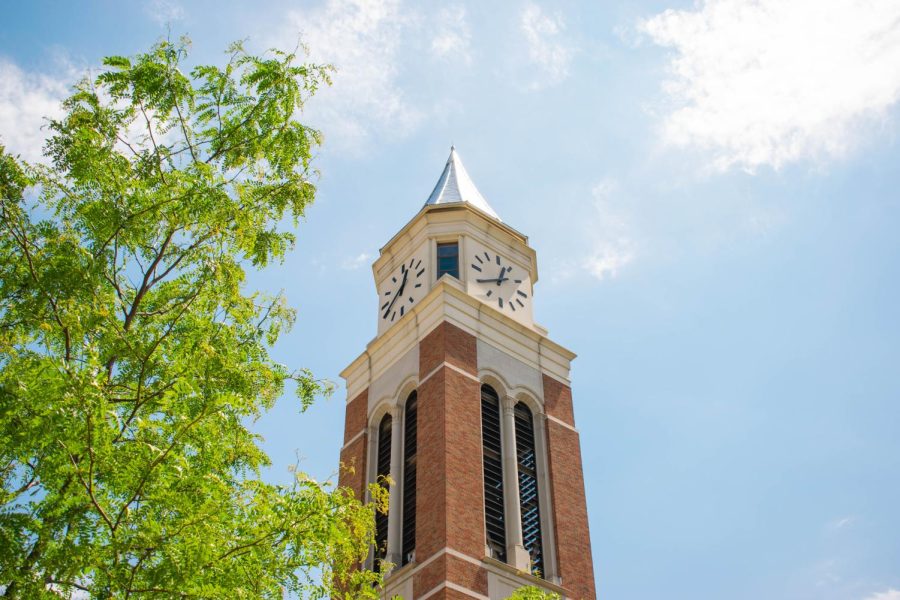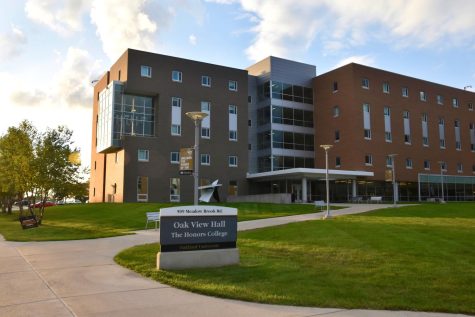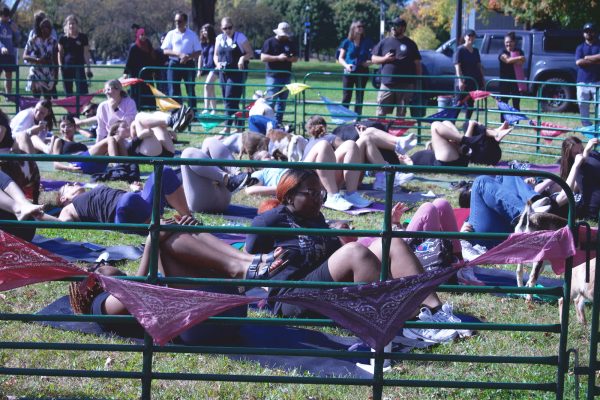BOT unanimously approves 3.9% tuition increase, $273.5M budget
Oakland University’s Board of Trustees (BOT) unanimously approved a tuition increase of 3.9% for Fall 2022 during a special meeting on Friday, July 1.
James Hargett, the university’s interim vice president for Finance and Administration, attributed this increase to inflation, research and instructional space needs and the maintenance of OU’s quality programs, competitive pricing and financial aid packages.
The BOT additionally cited the university’s position as the recipient of the least state funding across Michigan’s 15 public universities as rationale for the increase.
“We tried to come up with what we considered to be an increase which was both average with respect to what the other public universities were considering, and one that would not overly burden our students and our families — and yet, at the same time, would allow us to begin to address some of the university’s needs to be able to offer students a high quality education,” OU President Ora Hirsch Pescovitz said.
Resident, lower level undergraduate students attending classes full-time will now pay $14,572.50 in tuition, up $547.50 from last year. For upper level residents, full-time undergraduate tuition is up by $630 for a total of $16,875 per year. This brings the average cost of attendance up to $15,723.75.
OU’s 3.9% increase in tuition is similar to increases announced earlier in June by other public universities in the state:
- University of Michigan — 3.4%
- Michigan State University — 3%
- Wayne State University — 4.5%
- Grand Valley State — 2.9%
- Ferris State — 3.2%
- Saginaw Valley State — 3.9%
- Western Michigan — 3.85%
The approved general fund budget for fiscal year 2023 (FY2023) amounts to $273.5M in total and includes a $10.9M increase in expenditures. This increase will be spread out between a number of investments, including incremental costs toward salary and fringe benefits, utility costs and new academic programs. In reference to the latter, Hargett specifically highlighted the university’s recently approved physician’s assistant masters program, social work masters program and Bachelor of Science degree in nutrition.
In assembling this budget, the BOT accounted for a projected enrollment decrease of 8.8% and a $12.7M decline in net incremental revenue. These decreases are due in part to a shrinking pool of high school graduates — a crisis affecting universities statewide.
“The most important thing we can do is offer the highest quality education possible, and we work really hard to do that,” Pescovitz said regarding OU’s efforts to stimulate enrollment.
Among the main assets Pescovitz credits with making an OU degree valuable are the diverse array of internship opportunities offered to students and an average graduate salary of $58,000 — higher than both the state and national averages for graduates.
“It isn’t just that we offer an incredibly wonderful education – we really offer a great career,” Pescovitz said. “In addition, we offer excellent financial aid opportunities, and we are increasing the number of financial aid opportunities with scholarships, grants and work study opportunities — those kinds of things.”
OU received a significant $6.7M increase in state appropriations funding this year, for a total of nearly $60M. Pescovitz credited the Strive for 45 campaign with setting this increase in motion.
First introduced in 2020, ‘Strive for 45’ sought to establish more equitable state funding across Michigan’s 15 public universities through allocating at least $4,500 per fiscal year equivalent student in floor funding to each. In Friday morning’s approved budget, the state declared their intentions to increase floor funding at the five universities which previously received less than $5,000 by issuing them up to $4,500 over a three year period.
“That was due to very heavy advocacy at the legislative level,” Pescovitz said. “[For students,] it shows that when you advocate for something, and you do it in an aggressive way but also in a well thought out way, that you can change legislation — that you can make a difference.”
Aside from trustee Brian Calley’s inquiries regarding tuition rate projections for the coming years, the Q&A segment for this item concluded swiftly. The board members in attendance voted unanimously to approve the $273.5M budget and 3.9% tuition increase, and with no further items on the agenda, the meeting was adjourned in under 30 minutes.











jerome • Jul 7, 2022 at 8:42 AM
I am glad I am not paying for my tuition!
Anonymous • Jul 4, 2022 at 9:53 PM
Tenure track faculty have pay raises that will average out to about 2% per year. New faculty hires have taken a CUT to their retirement contributions of 3%. There is NO pension system at Oakland University, it is entirely a 403b/401k system.
Special Lecturers will earn between $1378 and $1603 per credit taught. That’s for the entire semester (not per month or per week). So, a Special Lecturer with 4-7 years experience and teaching a 4 credit class will make $5944 for the entire semester. The tuition from 3 students will pay the salary of the Special Lecturer. Special Lecturers have to pay for 65% of their health insurance premium, so many Special Lecturers opt not to take any health insurance. In addition, there is no retirement benefit at all for Special Lecturers, only what they save themselves.
Lecturers make less than Special Lecturers, are not entitled to health insurance, and have no retirement benefit.
The faculty contract is here for students to review: http://oaklandaaup.org/res/2021-24agreement.pdf
For many years the university has been projecting enrollment declines because they anticipated fewer students graduating from high school. We should ask ourselves then why was the Oakland Center expanded? Twice.
Varner Hall has desperately needed renovations. All of us realize this. But the BOT proposed a $45 million budget for this.
https://oaklandpostonline.com/34127/campus/varner-hall-renovation-expansion-unanimously-approved-for-2021/
South Foundation Hall was already renovated a few years ago. It’s being completely gutted, rebuilt, and expanded. And the budget is $40 million.
https://oaklandpostonline.com/34625/campus/south-foundation-renovation-and-addition-underway/
Wilson Hall was recently renovated and expanded by 40,000 square feet, to include a Welcome Center. Couldn’t this Welcome Center have been incorporated into the Oakland Center? Isn’t that the point of the Oakland Center? And did this require a budget of $20.54 million?
https://oaklandpostonline.com/33202/campus/wilson-hall-renovations-underway/
The BOT budgeted $3.715 million to purchase an off campus set of buildings for research space for the School of Engineering.
https://oaklandpostonline.com/33549/campus/bot-to-purchase-research-facility-review-hiring-practices/
The BOT purchased property on University Drive for use by the School of Medicine at a cost of $25 million.
https://oaklandpostonline.com/42397/campus/april-14-bot-meeting-new-25-million-acquisition-new-program-award-winners/
Now, granted that some of these budget items share cost with the state, so it’s not all on the university’s budget. And the cost for some of these items may go up or down as the projects are completed. But the important thing is that these are all projects authorized within the past 2 – 5 years that show NO sign of planning for enrollment declines.
Perhaps the State of Michigan needs to empower the faculty members to veto new building purchases and renovations that exceed $20 million in total cost?
I note the end of the article in which we are told that Brian Calley made brief inquiries regarding the tuition increases and then the meeting was swiftly concluded. Once again, as I frequently tell my students, decisions are not made in meetings. Decisions are made before meetings. The purpose of the meeting is to pretend like they are listening to input to try and convince everyone to get on board with the decision.
Linda S. • Jul 4, 2022 at 2:26 PM
“…projected enrollment decrease of 8.8% and a $12.7M decline in net incremental revenue. These decreases are due in part to a shrinking pool of high school graduates…”
Note the key phrase there…”in part”. How much of a part can it be, when the decrease in high school graduates is comprised mostly of dropouts and those having to repeat classes? These are not kids who would be accepted into most colleges anyway, even if they did apply.
So why isn’t the BOT taking a much closer look at the *other* cause(s) of the 8.8% decrease in enrollment? Could it be because the ones that actually play a significant role in that number reveal truths that they do not want to face?
I am a graduate of OU, and 3 of my children have been students at OU. One is already graduated, but two of them have transferred out solely because of the irresponsible and destructive behavior of the current OU Administration. In talking with other alumni parents and my childrens’ fellow students, this is a rapidly growing trend. Current students are voting with their feet. OU is getting a less than positive reputation with guidance counsellors in high schools. The word is out.
Next year at this time the BOT will vote for another increase. But when they do, they will be looking at a decrease in enrollment much bigger than 8.8%. The question is, will they continue to ignore the elephant in the room and blame high school dropouts for what is their own failure?